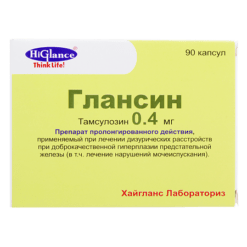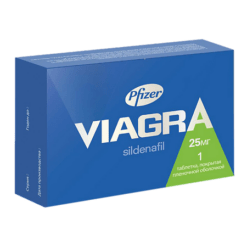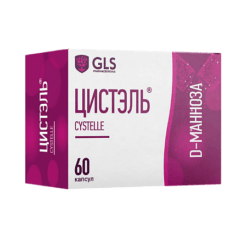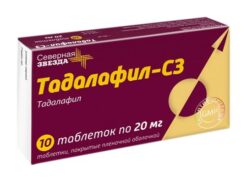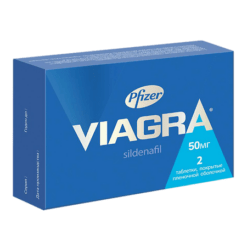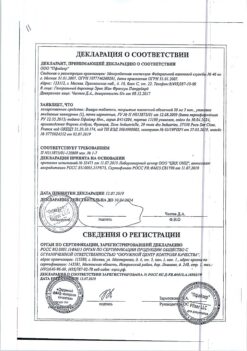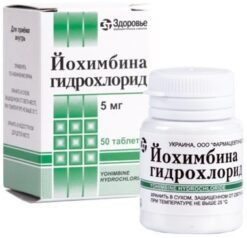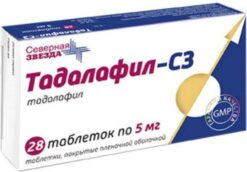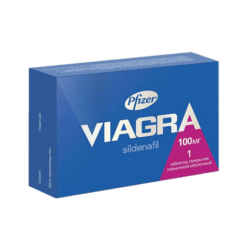No products in the cart.
Glansin, 0.2 mg 30 pcs.
€8.93 €7.81
Description
Pharmacological group: α1-adrenoblocker.
ATX code: G04CA02.
Pharmacological properties
Pharmacodynamics:
Tamsulosin is a specific blocker of postsynaptic α1-adrenoreceptors located in the smooth muscle of the prostate, bladder neck and prostatic urethra. Blockade of α1-adrenoreceptors by tamsulosin leads to reduction of the tone of the smooth muscles of the prostate, bladder neck and prostatic part of the urethra and improves the outflow of urine. Simultaneously both symptoms of emptying and symptoms of bladder filling caused by increased tone of smooth muscles and detrusor hyperactivity in benign prostatic hyperplasia are reduced.
The ability of tamsulosin to affect α1A subtype of adrenoreceptors is 20 times greater than its ability to interact with α1b subtype of adrenoreceptors located in vascular smooth muscle. Due to its high selectivity, the drug does not cause clinically significant reduction of systemic arterial blood pressure (BP) both in patients with arterial hypertension and in patients with normal baseline BP. The drug has prolonged action (with modified release).
Pharmacokinetics:
Tamsulosin is well absorbed in the intestine and has almost 100% bioavailability. Absorption of tamsulosin is somewhat slower after a meal. The same level of absorption can be achieved if the patient takes the drug after the usual breakfast each time. Tamsulosin is characterized by linear kinetics. After a single oral intake of 0.4 mg capsule on an empty stomach, the maximum concentration (Cmax) of tamsulosin in blood plasma is reached after 6 hours. When taking an oral capsule of 0.4 mg per day for several days, the equilibrium concentration is reached by day 5, with its value being approximately 2/3 that of this parameter after taking a single dose. Binding to plasma proteins is 99%. The volume of distribution is insignificant and is about 0.2 l/kg. Tamsulosin is slowly metabolized in the liver to form less active metabolites. Most of tamsulosin is present in plasma unchanged.
In mild to moderate hepatic impairment no dosing regimen adjustment is required.
Tamsulosin and its metabolites are mainly excreted in the urine, with about 9% of the drug excreted unchanged. The half-life of the drug in single use of tamsulosin capsule in dose of 0.4 mg after a meal is 10 hours; in case of use over several days – 13 hours.
In case of renal failure no dose reduction is required; in patients with severe renal failure (creatinine clearance less than 10 ml/min) tamsulosin should be administered with caution.
Indications
Indications
Active ingredient
Active ingredient
Composition
Composition
Each modified-release capsule contains:
Active ingredient: tamsulosin hydrochloride pellets 0.2 %* – 100 mg,
Tamsulosin hydrochloride containing 0.2 mg
Pellet excipients: sugar grits [sucrose, starch treacle] 91.33 mg, ethyl cellulose 0.8 mg, methylacrylic acid and ethyl acrylate copolymer [1:1] 7.05 mg, macrogol-6000 0.62 mg
Excipients:sugar grits [sucrose, starch treacle] 160.0 mg
Capsule cap: gelatin 20.1157 mg, water 3.4800 mg, iron oxide red dye 0.1440 mg, iron oxide yellow dye 0.0799 mg, titanium dioxide 0.1612 mg, sodium lauryl sulfate 0.0190 mg
Capsule cap: gelatin 32.6880 mg, water 5.6550 mg, iron oxide red dye 0.2340 mg, iron oxide yellow dye 0.1299 mg, titanium dioxide 0.2619 mg, sodium lauryl sulfate 0.0312 mg
Capsule shell ink: ethanol 30-34 %, 2-propanol 3-6 %, butanol 3-6 %, propylene glycol 0.5-2 %, polysorbate 80 0-1 %, shellac 20-25 %, titanium dioxide 30-34 %.
How to take, the dosage
How to take, the dosage
Interaction
Interaction
In concomitant use with cimetidine, a slight increase in tamsulosin plasma concentrations was noted, with furosemide – a decrease in tamsulosin concentration, but this does not require changing the tamsulosin dose, since the drug concentration remains within the normal range. Diclofenac and warfarin may slightly increase the excretion rate of tamsulosin. Concomitant use of tamsulosin with other α1 adrenoreceptor antagonists may result in a decrease in BP. When concomitant use with atenolol, enalapril, nifedipine, no drug interaction has been found. Diazepam, propranolol, trichloromethiazide, chlormadinone, amitriptyline, diclofenac, glibenclamide, simvastatin and warfarin do not change free fraction of tamsulosin in human plasma in vitro. Tamsulosin does not alter the free fractions of diazepam, propranololol, trichloromethiazide, and chlormadinone. In in vitro studies no interaction at the level of hepatic metabolism was found with amitriptyline, salbutamol, glibenclamide and finasteride.
The concomitant use of tamsulosin with potent CYP3A4 isoenzyme inhibitors may increase the effect of tamsulosin. Concomitant use with ketoconazole (a known potent CYP3A4 inhibitor) increases the area under the “concentration-time” curve (AUC) Cmax of tamsulosin with the coefficient of 2.8 and 2.2, respectively. Tamsulosin should not be used concomitantly with potent CYP3A4 inhibitors in patients with the slow metabolism phenotype of CYP2D6 isoenzyme. When tamsulosin was used concomitantly with paroxetine (a potent CYP2D6 isoenzyme inhibitor), the AUC and Cmax of tamsulosin increased 1.3 and 1, 6 times, respectively, but this increase was not clinically significant.
Special Instructions
Special Instructions
With caution, the drug should be administered in severe renal insufficiency (creatinine clearance less than 10 ml/min), as well as when using other α1-adreno-blockers. The drug should be used with caution in patients with predisposition to orthostatic hypotension. At the first signs of orthostatic hypotension (dizziness, weakness), the patient should sit or lie down and stay in this position until the above symptoms disappear. Before starting the drug, it is necessary to verify the diagnosis and rule out the presence of other diseases which may cause similar symptoms.
Performance of a finger rectal examination and, if necessary, determination of prostate specific antigen (PSA) must be performed before starting therapy and regularly during therapy.
It is advisable to stop taking the drug 1-2 weeks before surgery for cataract and glaucoma (against the background of taking the drug it is possible to develop syndrome of intraoperative iris instability (syndrome of narrow pupil), which the surgeon should consider for preoperative preparation of the patient and during surgery). There are reports of cases of prolonged erection and priapism during therapy with alpha1-adrenoblocators. If an erection persists for 4 hours, seek medical advice immediately. If therapy of priapism is not carried out immediately, it may lead to damage of penile tissues and permanent loss of potency.
One capsule (0.2 mg or 0.4 mg) contains 0.26 g of carbohydrates, which corresponds to 0.026 IU (1 IU (bread unit) – 10 g of carbohydrates). The minimum quantity of carbohydrates allows to prescribe the preparation to patients with diabetes.
Influence on driving and operating ability
When using the drug, caution must be exercised while driving vehicles and engaging in other potentially dangerous activities which require increased concentration and quick psychomotor reactions, because the drug may cause headache.
The drug may cause dizziness and other side effects which may affect the above abilities.
Synopsis
Synopsis
Contraindications
Contraindications
Hypersensitivity to tamsulosin or any other component of the drug; sucrose/isomaltase deficiency; fructose intolerance; glucose-galactose malabsorption; orthostatic hypotension (including anamnesis); severe hepatic insufficiency, childhood under 18 years.
With caution – severe renal insufficiency (creatinine clearance less than 10 ml/min); arterial hypotension, when concomitantly used with α1-adrenoblockers.
Side effects
Side effects
Gradation of the frequency of side effects:
very often >1/10
frequently from > 1/100 to < 1/10
infrequent from > 1/1000 to < 1/100
frequently from >1/10,000 to < 1/1000
very rarely from < 1/10,000, including individual posts.
Cardiovascular system disorders: not infrequently- palpitations, postural hypotension, very rarely- atrial fibrillation, dyspnea, arrhythmia. Gastrointestinal tract: frequently – constipation, diarrhea, nausea, vomiting, very rarely – dry mouth. Nervous system disorders: frequently – dizziness; infrequently – headache, frequently – fainting, drowsiness. Reproductive system: frequently – disorders of ejaculation, very frequently – priapism. Respiratory, chest and mediastinum disorders: infrequent rhinitis, very rarely – nasal bleeding. Skin and subcutaneous tissue disorders: infrequent – rash, itching, urticaria; frequently – angioedema (including Quincke’s edema); very rarely – Stevens-Johnson syndrome, erythema multiforme, exfoliative dermatitis. General condition disorders: infrequent – asthenia. Other: intraoperative iris instability (narrow pupil syndrome) during cataract surgery in patients taking tamsulosin.
Overdose
Overdose
No cases of acute overdose of the drug have been reported.
Symptoms Acute arterial hypotension and compensatory tachycardia may occur.
Treatment Symptomatic therapy is carried out: keeping the patient in a horizontal position and, if necessary, administration of plasma exchange solutions or vasoconstrictor drugs. Renal function should be monitored. It is unlikely that dialysis will be effective, since 99% of tamsulosin is bound to plasma proteins.
In order to prevent further absorption of tamsulosin, gastric lavage, administration of activated charcoal or osmotic laxatives are possible.
Pregnancy use
Pregnancy use
Similarities
Similarities
Additional information
| Shelf life | 4 years. Do not use after the expiration date. |
|---|---|
| Conditions of storage | Store at the temperature not more than 25 °С. Keep out of reach of children. |
| Manufacturer | Hyglans Laboratories Pvt. Ltd, India |
| Medication form | modified-release capsules |
| Brand | Hyglans Laboratories Pvt. Ltd |
Other forms…
Related products
Buy Glansin, 0.2 mg 30 pcs. with delivery to USA, UK, Europe and over 120 other countries.



